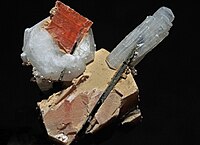
Photo from wikipedia
AbstractY-zeolite was first modified by means of ions exchange with Al, Ca and Na, respectively. The modified materials were characterized by using X-ray diffraction (XRD), scanning electron microscopy (SEM) and… Click to show full abstract
AbstractY-zeolite was first modified by means of ions exchange with Al, Ca and Na, respectively. The modified materials were characterized by using X-ray diffraction (XRD), scanning electron microscopy (SEM) and inductively coupled plasma optical emission spectrometry (ICP-OES). Gas sensors were fabricated by SnO2 and coating Y-zeolites on the outside of SnO2 surface, respectively. It was found that the responses of the composites of all types of zeolite- and SnO2-based sensors became lower comparing with that of the pure SnO2-based one response of SnO2 sensor to ethanol vapor. It indicates a suppression effect of zeolites on the response to ethanol vapor. In contrast, the response of the composite-sensing materials of the modified Y-zeolite/SnO2-based sensors except the Ca-modified one to acetone indicates a significantly improved response, 2–3 times higher than that of pure SnO2-based sensor which is smaller than the one of SnO2 sensor. The possible mechanism of the effects of the Y-zeolites on the response of the sensors has been discussed.
Journal Title: Journal of Materials Science
Year Published: 2018
Link to full text (if available)
Share on Social Media: Sign Up to like & get
recommendations!